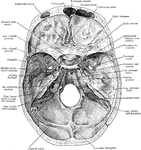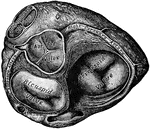
Cross Section of the Trunk at the Level of Junction of the Manubrium
Section at the level of the junction of the manubrium and corpus sterni, exposing the great vessels…
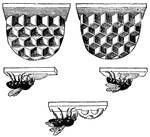
Cells Constructed by Bees
"Each cell forms a small, hexagonal cup, closed on one side only by a pyramidal base. These bees always…
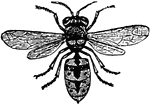
Common Wasp (Vespa Vulgaris)
"Wasps live in companies, which last only a year and are composed of males, females and workers. Their…
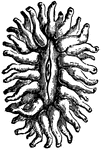
Flabellum Pavonium (Lesson)
"In the subfamily of the Zoanthidae, the polyps occur in clusters, and are multiplied by buds, rising…

Blue Minyad (Minyas Cyanea)
"The Blue Minyad is a type of a family in which the base of the body, in place of extending itself in…
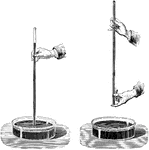
Torricellian Experiment
This experiment showed that every surface exposed to the atmosphere sustains a normal pressure equal…

Pennatula Spinosa
"These winged species of polypidom are somewhat scythe-shaped, well developed, and furnished with a…
Loose Winged Virgularia (Virgularia Mirabilis)
"These winged species of polypidom are somewhat scythe-shaped, well developed, and furnished with a…
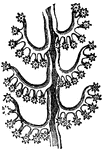
Branch of Loose Winged Virgularia
"These winged species of polypidom are somewhat scythe-shaped, well developed, and furnished with a…
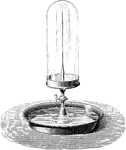
Fountain in Vacuo
This apparatus consists of a bell-shaped vessel of glass, the base of which is pierced by a tube fitted…
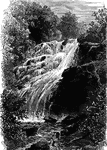
Torc Waterfall, Killarney
Torc Waterfall is a notable tourist attraction at the base of Torc Mountain, about 5 miles (8.0 km)…
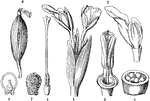
Chinese Ginger
Chinese Ginger or fingerroot (Boesenbergia rotunda): "Flowers of Kaempferia pandurata; 2. the inner…

Nutmeg
"Myristica fragrans. 1. a flower; 2. a column of stamens; 3. a section of a female showing the ovary…
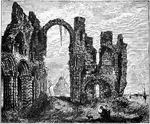
Lindisfarne Priory Ruins before 1860
The monastery of Lindisfarne was founded by Irish born Saint Aidan, who had been sent from Iona off…
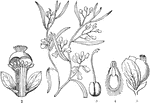
Milkwort
"Polygala erioptera. 1. an entire flower seen from the side; 2. the same cut open to exhibit the stamens;…

Aptandra
"Aptandra Spruceana. 1. an expanded flower; 2. a petal; 3. tube of stamens, with 4 petaloid glands at…
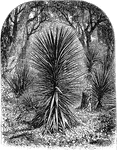
Spanish Dagger (Yucca)
An illustration of the Yucca gloriosa, commonly referred to as the Spanish Dagger. The yucca gloriosa…
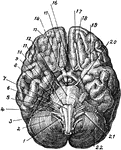
Base of Brain
The base of the brain. Labels: 1, eleventh or spinal accessory nerve; 2, right hemisphere of cerebellum;…
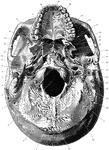
Base of the Skull
Shown is norma basalis, which refers to the base of the cranium. Labels: 1, external occipital crest;…
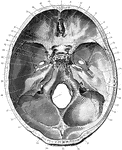
Base of the Skull Seen From Above
Shown is the base of the skull seen from above. Labels: 1, frontal bone; 2, slit for nasal nerve; 3,…

Litsea
"Litsaea Baueri. 1. a male flower; 2. a female; 3. a stamen, with a gland at the base; 4. an anther,…
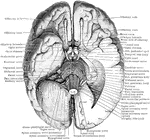
Base of the Brain
The base of the brain. The under part of the left temporal and occipital lobes has been sliced off so…
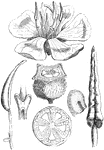
Native Lassiandra
"Melastoma polyanthum. 1. flower; 2, 2. stamens; 3. base of anther; 4. fruit; 5. section of ditto; 6.…
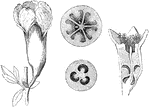
Pomegranate
"Punica granatum; 2. perpendicular section of the ovary; 3. cross section of it near the base; 4. near…
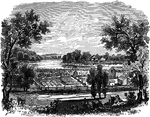
Site of Fort Defiance, in 1860
In the 1810s, William Henry Harrison used Fort Defiance as one base for his attacks against Native Americans…

Pyramids
An illustration of two pyramids. A pyramid is a building where the upper surfaces are triangular and…

Model 23, Mark I (Rifle)
This grenade is nothing more than the No. 5 fitted with a rod 5¼ inches long screwed into a steel…

Cavity of Larynx
Cavity of larynx, as seen by means of the laryngoscope. A, the rima glottidis closed. B, the rima glottidis…

Mediastinal Surfaces of the Lungs
Mediastinal surfaces of the two lungs of a subject hardened by formalin injection. A, right lung. B,…

Blood Supply of Caecum and Appendix
The blood supply of the caecum and vermiform appendix. The illustration to the left gives a front view,…

Western Wood Pewee
The Western Wood-Pewee, Contopus sordidulus, is a small tyrant flycatcher. Adults are gray-olive on…
Pillar
A decorative Egyptian pillar. A pillar is similar to a column which is a vertical support structure…
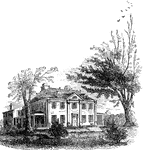
Washington's Headquarters at Cambridge, 1775
Washington used the home as his headquarters and home while he planned the Siege of Boston between July…

Washington's Headquarters at New York
The Morris-Jumel Mansion (also known as the Roger and Mary Philipse Morris House), located in historic…
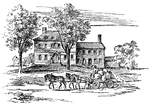
Washington's Headquarters at Morristown
The Ford Mansion is part of the Morristown National Historical Park, and is located on a hilltop in…

Inferior Aspect of Horse Skull
Inferior aspect of horse's skull, the mandible being removed. Above the line A is the posterior region…

The Yorktown Monument
Yorktown was the base of British General Charles Cornwallis during the 1781 siege, which was the last…

Ruins of the Sphinx Temple
The Great Sphinx is a statue with the face of a man and the body of a lion. Blocks of stone weighing…
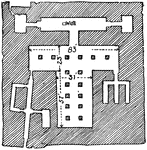
Plan of the Sphinx Temple
The Great Sphinx is a statue with the face of a man and the body of a lion. Blocks of stone weighing…
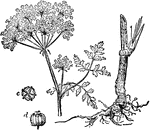
Northern Water Hemlock
Northern Water Hemlock is a species of Cicuta, native to northern and central Europe, northern Asia…
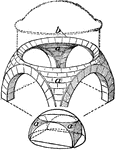
Diagram of Pendentives
A pendentive is a constructive device permitting the placing of a circular dome over a square room or…
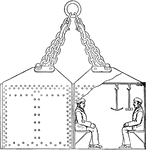
Diving Bell
A diving bell, also known as a wet bell, is a cable-suspended airtight chamber, open at the bottom like…

Spleen of a Horse
Internal aspect of the spleen. Labels: a, superior extremity, or base; b, inferior extremity; c, internal…

Railway Turntable
"Industrial-railway Turn-table. a, circular base with channel for ball-bearing, showing ring of balls;…
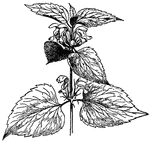
Lamium Album
Lamium album (White Deadnettle) is a flowering plant in the family Lamiaceae, native throughout Europe…

Respiratory Organs of a Horse
General view of the respiratory organs. Labels: a, septum nasi; b, posterior naris; c, larynx; d, trachea;…

Pillar in Trimal Naik's Tschultri
A pillar is similar to a column which is a vertical support structure in architecture, but the base…

Great Pyramid of Giza, Section of the Grand Gallery
The Grand Gallery features a corbel haloed design and several cut "sockets" spaced at regular…
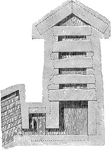
Great Pyramid of Giza, King's Chamber
The King's Chamber is lined with red granite brought from Aswan 935 km (580 miles) to the south, of…

Wood Rose
"Wood-rose, a remarkable vegetable excrescence, resembling a flower with radiating corrugated petals…
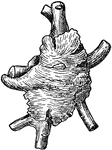
Wood Rose
"Wood-rose, a remarkable vegetable excrescence, resembling a flower with radiating corrugated petals…

Running Part
"Running-part. Naut., that part of a rope which is hauled upon is called the hauling-part (b), the part…
Pillar at the Temple at Edfu
At the lower part of the capital there frequently occurs an ornament of diminishing triangles, resembling…
Pillar at the Palace at Luxor
At the lower part of the capital there frequently occurs an ornament of diminishing triangles, resembling…
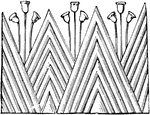
Capital Ornament in the Temple at Edfu
At the lower part of the capital there frequently occurs an ornament of diminishing triangles, resembling…

Ornament at the foot of the wall from the Great Temple at Philæ
They are generally of smaller dimensions in the interior, so that the walls or columns of the same chamber…


